Clusiaceae (Mangosteen family)
At a Glance
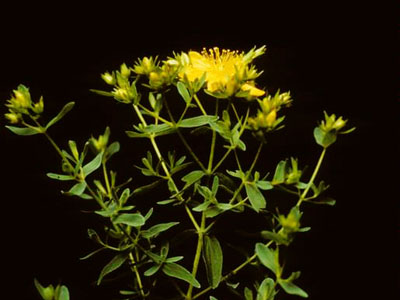
Ohio State Weed Lab / The Ohio State University / Bugwood.org
- Perennial
- One to 30 stems that branch near the top.
- The stems have numerous sterile shoots that arise from the lower leaf axils.
- Opposite leaves dotted with many translucent glands.
- Bright yellow flowers cluster at stem tips.
- Fruit is sticky and three-chambered.
Habitat and Ecology
Native to Europe, western Asia, and North Africa, St. Johnswort (Hypericum perforatum) is now widely distributed across the temperate regions of the world. It was likely introduced to North America many times and was established in many western states by the early 1900s. Control with leaf-feeding flea beetles and root-boring beetle has dramatically reduced St. Johnswort infestations, but localized outbreaks can still occur after disturbance or during the low population cycles of the insects. St. Johnswort invades rangelands, fields, roadsides, and forest clearings. It grows best on well-drained, coarse-textured, and slightly acid to neutral soils. The black oil glands on the foliage contain hypericin, a fluorescent red pigment that causes light sensitivity and death in livestock.
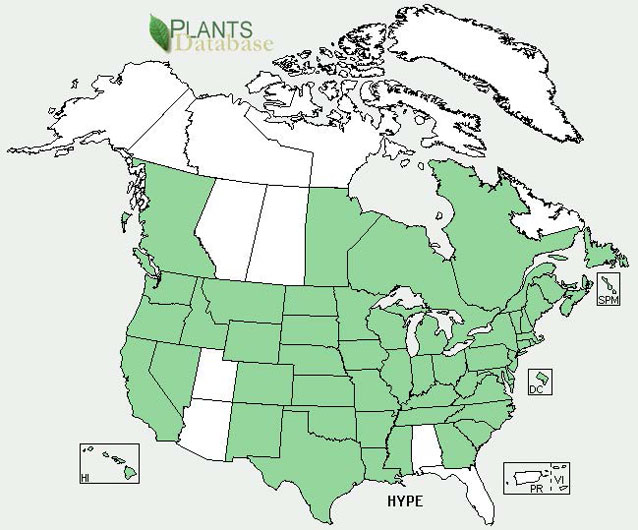
USDA
Description
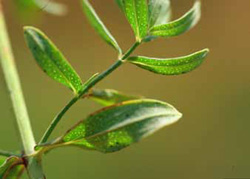
© Steve Dewey / Utah State University
St. Johnswort is an erect perennial with showy, bright yellow flowers. One to 30 stems, each with many branches near the top, arise from a woody root crown. The stems have numerous sterile shoots, each about one to four inches long, that arise from the lower leaf axils (spaces between the leaves and the stem). Often reddish, the stems can have black glands located along the two ridges of the stem. The root system consists of a stout taproot with many branched lateral roots. In addition, rhizomes (horizontal, underground stems) develop just below the soil surface and can extend outwards up to 1.5 feet. Pieces of rhizome can develop into new plants. St. Johnswort also reproduces by seeds that can remain viable for about ten years in the soil. The seeds and fruits disperse via water, machinery, shoes, clothing, and animal fur. Although St. Johnswort is a prolific producer of seeds, the plants have specific environmental requirements for germination and seedling growth, and therefore very few seedlings are usually found among stands of mature plants.
Leaves
The leaves are opposite and linear. Each leaf has three to five veins. When the leaf is held up to the light, many tiny translucent glands are visible. The leaf margins roll under, and the edges of the underside of the leaves are lined with elevated black glands.
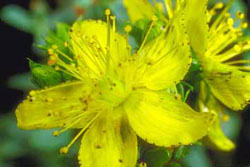
© Norman E. Rees / USDA ARC
Flowers and Fruits
The bright yellow flowers cluster at the stem tips. Each flower is a little less than one inch in diameter and has five petals. The petals are dotted with black glands along the margins. St. Johnswort flowers June through September. The fruit is a sticky, three-chambered capsule (a dry fruit composed of more than one carpel that opens at maturity). The seeds inside are shiny black to brown and densely pitted. They are often coated with gelatinous material that aids dispersal and may inhibit germination until breakingdown in four to six months.
Etymology
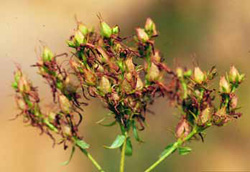
© Steve Dewey / Utah State University
Hyper’icum is an ancient Greek name derived from hyper, meaning “above,” and eikon, meaning “picture,” from the old practice of placing flowers above an image in the house to ward off evil spirits at the midsummer festival of Walpurgisnacht. This festival, which is held in late June when the plants are in bloom, later became the feast of St. John. Perfora’tum refers to paired leaves that are joined at the base and are thus “perforated” by the stem.
Ethnobotany
St. Johnswort has a long history of use for medicinal purposes. Hypericin, which is a fluorescent red pigment contained in the oil glands on the leaves, is the antidepressant ingredient in St. John’s wort remedies.
Similar Species
Native species of Hypericum have at least one of the following characteristics: 1) prostrate with matted stolons, 2) leaves with acute tips, 3) leaves folded along the midrib, 4) sterile shoots are shorter than an inch long, and 5) threelobed capsules.
Control Methods
Possible control methods are explained at these websites:
References
California Department of Food and Agriculture. No date. Common St. Johnswort or klamathweed in Encycloweedia. Available at https://www.cdfa.ca.gov/plant/ipc/encycloweedia/weedinfo/hypericum.htm (accessed 6 April 2010).
Charters, M. L. 2009. California plant names: Latin and Greek meanings and derivations. Available at http://www.calflora.net/botanicalnames (accessed 7 April 2010).
Zouhar, K. 2004. Hypericum perforatum in Fire Effects Information System. US Department of Agriculture, Forest Service, Rocky Mountain Research Station, Fire Sciences Laboratory. Available at http://www.feis-crs.org/feis/ (accessed 6 April 2010).
Prepared by Kelly Reeves, Southern Colorado Plateau Network Inventory and Monitoring Program, 2010.
Last updated: May 26, 2016
